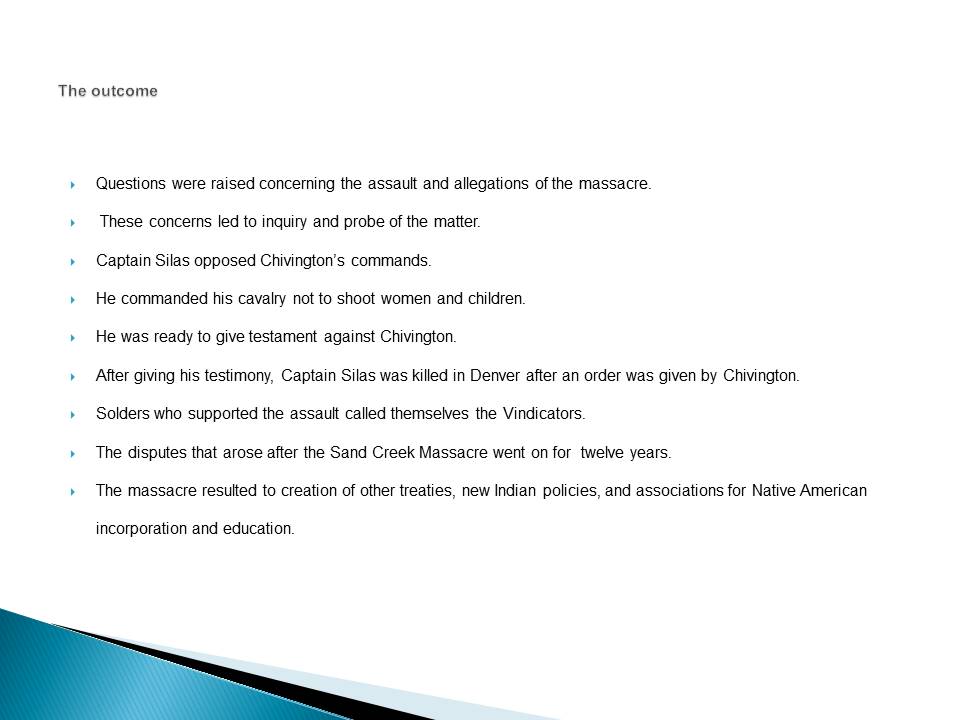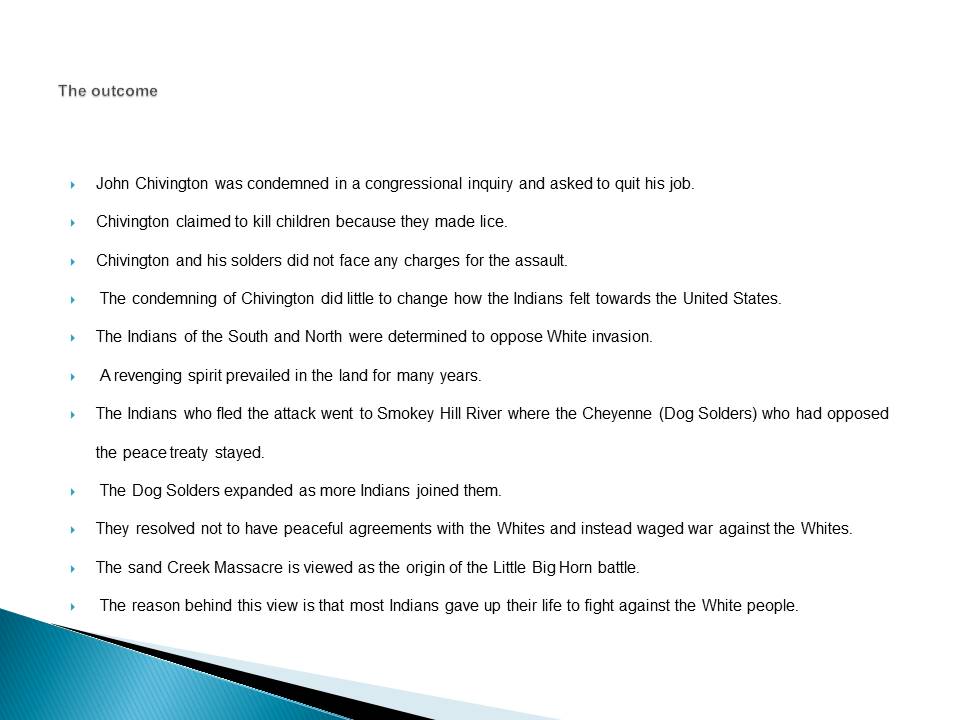Table of Contents
Introduction
- The Sand Creek Massacre was one of the ill-famed incidents in American History.
- In 1864, the Colorado Territory solders planned to assail the Cheyenne and Arapaho Indian villages.
- John Chivington was the leader of the solders.
- He was both a sermonizer and a freemason.
- He commanded the solders to butcher the Indians after the solders spent their night drinking excessively.
- Over sixty percent of the killed Indians were women and children.
- This heinous act has since been known as the Sand Creek Massacre.
- Different reports were given to the press regarding the massacre.
- It was reported that the Cheyenne people were able to resist the attack.
- This report was contrary to the report given by eyewitnesses.
- Further investigation was done concerning the incident.
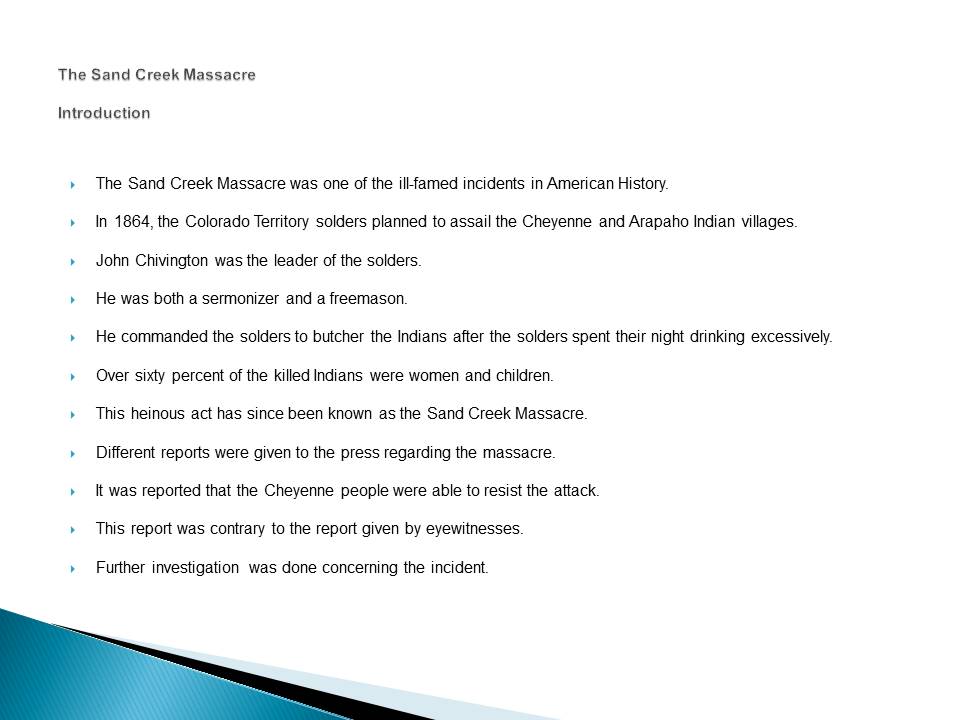
History
- At the start of Civil War, John Chivington rejected the position of chaplaincy because he preferred fighting.
- He became a military officer for Colorado volunteers.
- Chivington inspired his troop during war.
- He received admiration for his success in the Battle of Glorieta Pass.
- Although, the Confederates conquered, John hindered their operation into New Mexico when he took hold of their supply wagons and destroyed them.
- John’s deeds raised controversy in American History.
- Disagreement between the Indians and the United States existed because of land issues.
- The treaty of Fort Laramie allowed the Indians to occupy large territories.
- Pikes Peak gold rush pleaded the government to change the terms of the treaty.
- The Cheyenne and Arapaho people came to Colorado in the 1800s.
- They began their journey from Minnesota.
- Towns emerged quickly because of the gold discovery.
- As a result, the Territory of Colorado was established in 1861.
- The Cheyenne and Arapaho were nomadic people hence required extensive land.
- The region they inhabited was only a small percentage of what they had been promised.
- With the development of the new territory, conflict began between the initial inhabitants and the Indians.
- In addition, there was stiff competition for resources.
- This caused cultural differences between the Indians and the Whites.
- The Indians began to capture trains and mining camps.
- This act by the Indians was enhanced during the Civil War.
- During the Civil War a high percentage of soldiers died.
- A plan was made to kill the Indians when the battle between the Indians and the miners prevailed.
- Tension arose, and US solders murdered the Cheyenne chief.
- The camps of the Cheyenne people were destroyed and the hand of Arapaho chief was shot.
- The Hungate family was murdered near Denver.
- When their butchered bodies were exposed to the people, the inhabitants were afraid.
- Authorized statements to murder and demolish were given in conjunction with promise of reprieve for the Indians who obeyed.
- In August, a volunteer troop was formed with order from the War Department.
- The volunteer troop would serve against the Indians.
- Thousands of people offered themselves to join the volunteer troop.
- In 1861, the Treaty of Fort Wise withdrew land from the Indians.
- The Cheyenne and Lakota chiefs accepted the terms of the treaty.
- The Indians were left with only a small percentage of the original territory.
- The Indian chiefs signed the treaty to guarantee the safety of their communities.
- However, not all Indians were happy with the decision to sign the Fort Laramie Treaty.
- The Cheyenne and Lakota group strictly rejected the idea of the United States taking their land.
- To end the attack against the Indians, Black Kettle and White Antelope, planned to form peace talks with the United States.
- They were commanded to go to Fort Lyon and hold the American flag as a sign of surrender.
- Despite of flying the American flag, many Indians were massacred when male Indians were out in the fields hunting.
- Although the Arapaho and Kiowa Indians said their predecessors were at the Sand Creek.
- It is documented that the Arapaho and Kiowa Indians always took a distance of eight miles from the Cheyenne.
- Cheyenne Indians stated there was no other group of Indians in the massacre apart from them.
- The Cheyenne Indians, from their spiritual encounter at the location, claimed that the Sand Creek Massacre occurred at Dawson’s Bend in Sand Creek.
- Dawson was the name of a rancher on that location for almost forty years.
- The soldiers fired, maimed, sexually assaulted, beheaded, and butchered almost five hundred Cheyenne people.
- Those who came through the massacre gave tales to their people.
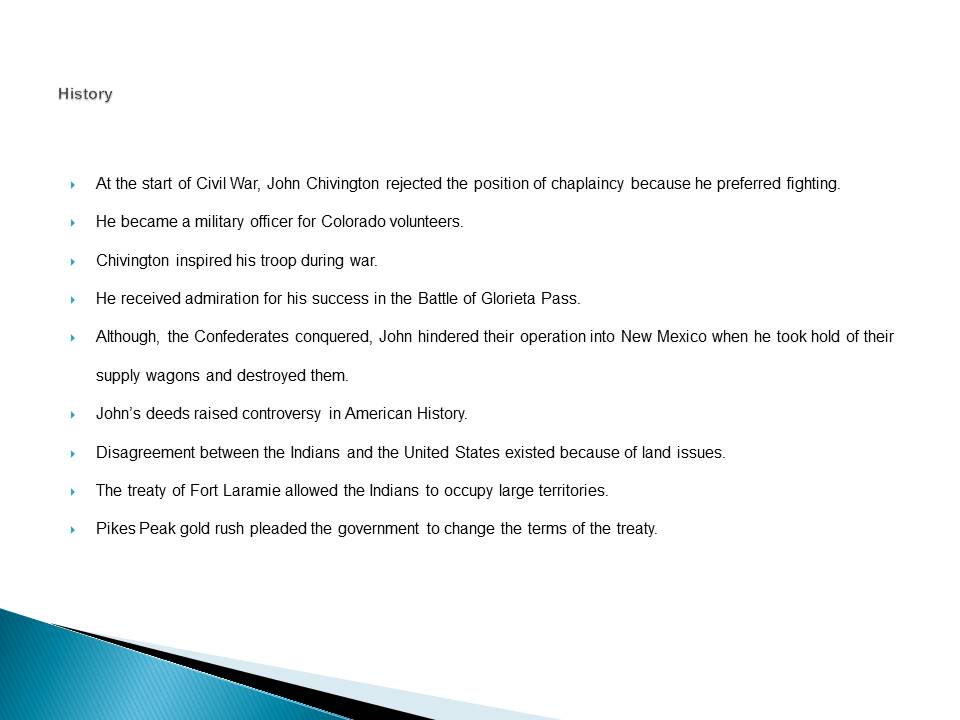
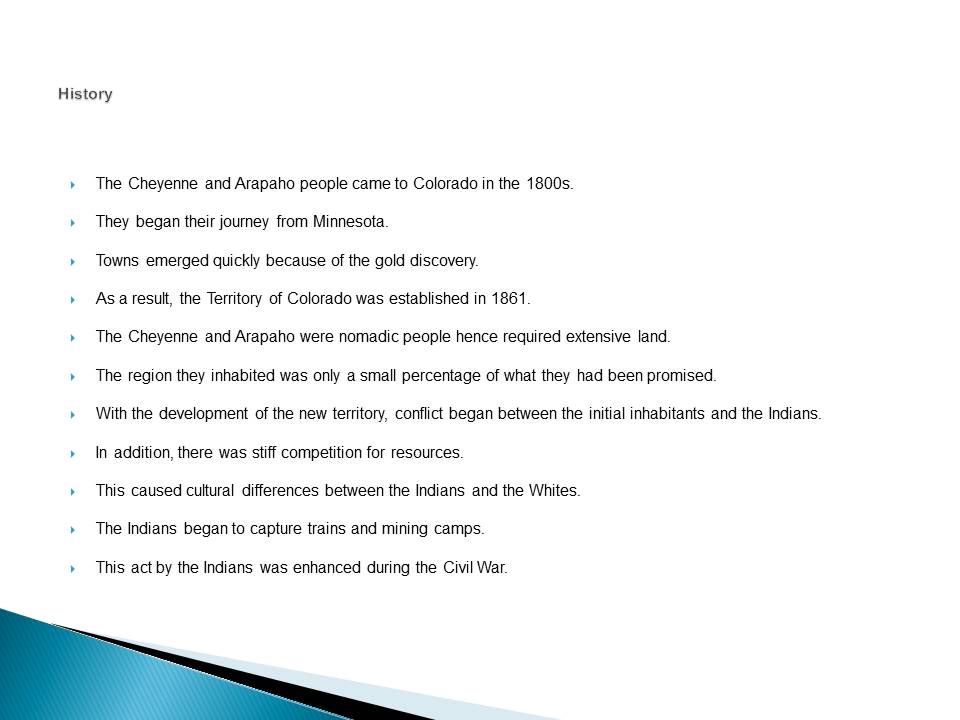
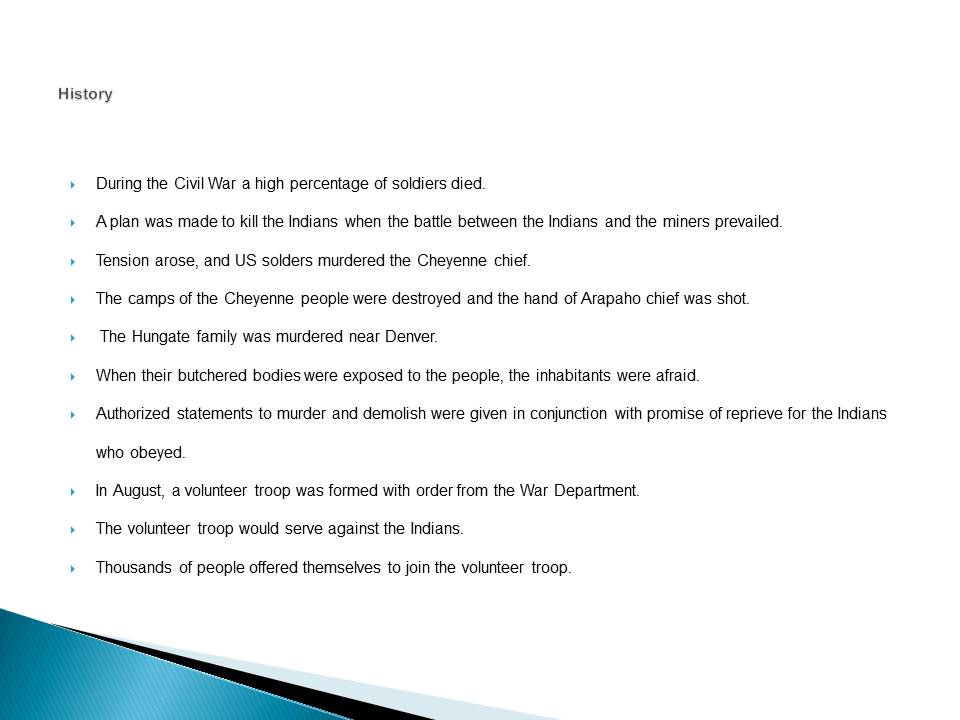


Causes of the Sand Creek Massacre
- One of the causes of the sand creek massacre was a communication issue.
- John Evans, governor of Colorado gave a statement to all Indians in 1864.
- The statement instructed Indians to surrender their weapons in the nearest fort.
- In return, the Indians would receive provisions and learn how to farm.
- He stated that those who objected the order would be viewed as criminals.
- He said they would be tracked down, persecuted, and imprisoned.
- The Cheyenne community did not receive the statement immediately but after three months.
- By the time the Indians went to fort Lyon, the plan to attack them was underway.
- John Evans got news that the Indians were meeting at Smoky Hill.
- He was informed that the Indians were planning to assault Denver City.
- Evans asked for help from secretary of war because of terror of the assault.
- However, his request was rejected because the American Civil War was in progress and most solders participated.
- The Indians managed to meet Governor Evans at Camp Weld.
- They were given command to hand in their weapons at Fort Lyon.
- After giving up their weapons they went to Sand Creek.
- At Sand Creek, they were to receive provisions and learn how to do farming.
- Chivington, who detested Indians, vied for Congress together with Evans.
- Chivington lost the seat and Evans pulled out his name from the election.
- Concurrently, Colorado people voted against the idea of Colorado becoming a state.
- Seven hundred militia commanded by Chivington assaulted many Cheyennes Indians at the Sand Creek.
- Chivington disregarded the peace treaty and was armed for war.
- The Indians were not prepared for any attack and therefore John and his solders conquered without much struggle.
- Very few Indians managed to resist the war while others fled through the stream.
- The Cheyenne ran northward and excavated hiding places in the ground.
- However, they were barraged with howitzer shells.
- The solders stopped the attack when they realized they had a shortage of weapons.
- Chivington left his goal of advancing northward to attack the Indians.
- He guided his solders to the Arkansas valley to chase the Arapaho group, and later moved to Denver.
- Crooked Indian agents played a role in the Sand Creek Massacre.
- These agents sold the provisions they received from the government instead of obeying the agreement at Fort Wise.
- The voracity and selfishness of the agents made the Cheyenne people weak and needy.


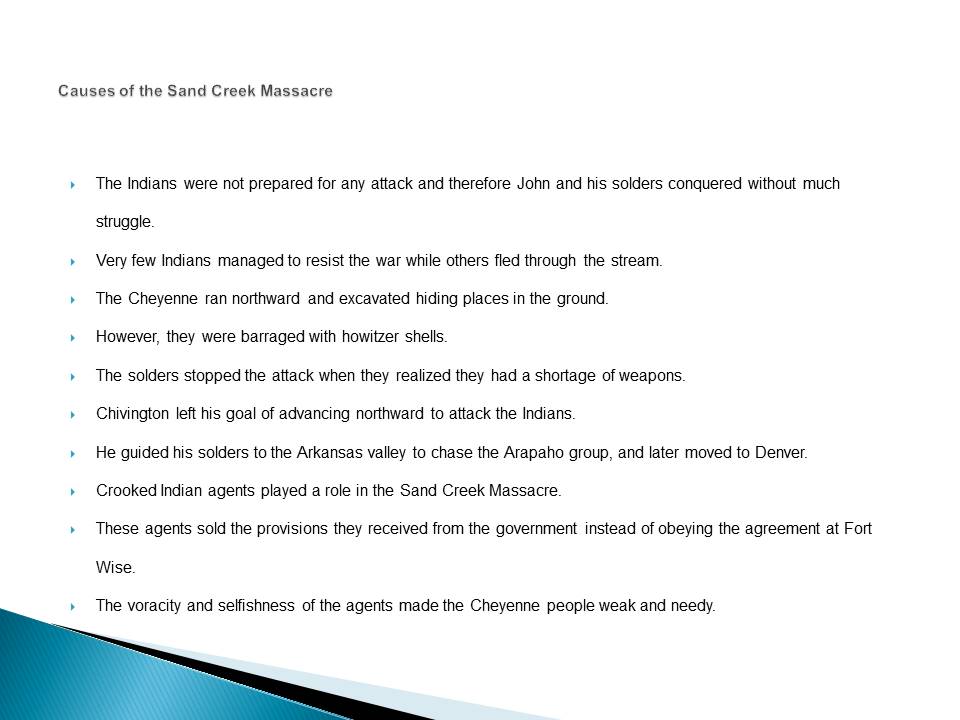
The outcome
- Questions were raised concerning the assault and allegations of the massacre.
- These concerns led to inquiry and probe of the matter.
- Captain Silas opposed Chivington’s commands.
- He commanded his cavalry not to shoot women and children.
- He was ready to give testament against Chivington.
- After giving his testimony, Captain Silas was killed in Denver after an order was given by Chivington.
- Solders who supported the assault called themselves the Vindicators.
- The disputes that arose after the Sand Creek Massacre went on for twelve years.
- The massacre resulted to creation of other treaties, new Indian policies, and associations for Native American incorporation and education.
- John Chivington was condemned in a congressional inquiry and asked to quit his job.
- Chivington claimed to kill children because they made lice.
- Chivington and his solders did not face any charges for the assault.
- The condemning of Chivington did little to change how the Indians felt towards the United States.
- The Indians of the South and North were determined to oppose White invasion.
- A revenging spirit prevailed in the land for many years.
- The Indians who fled the attack went to Smokey Hill River where the Cheyenne (Dog Solders) who had opposed the peace treaty stayed.
- The Dog Solders expanded as more Indians joined them.
- They resolved not to have peaceful agreements with the Whites and instead waged war against the Whites.
- The sand Creek Massacre is viewed as the origin of the Little Big Horn battle.
- The reason behind this view is that most Indians gave up their life to fight against the White people.
